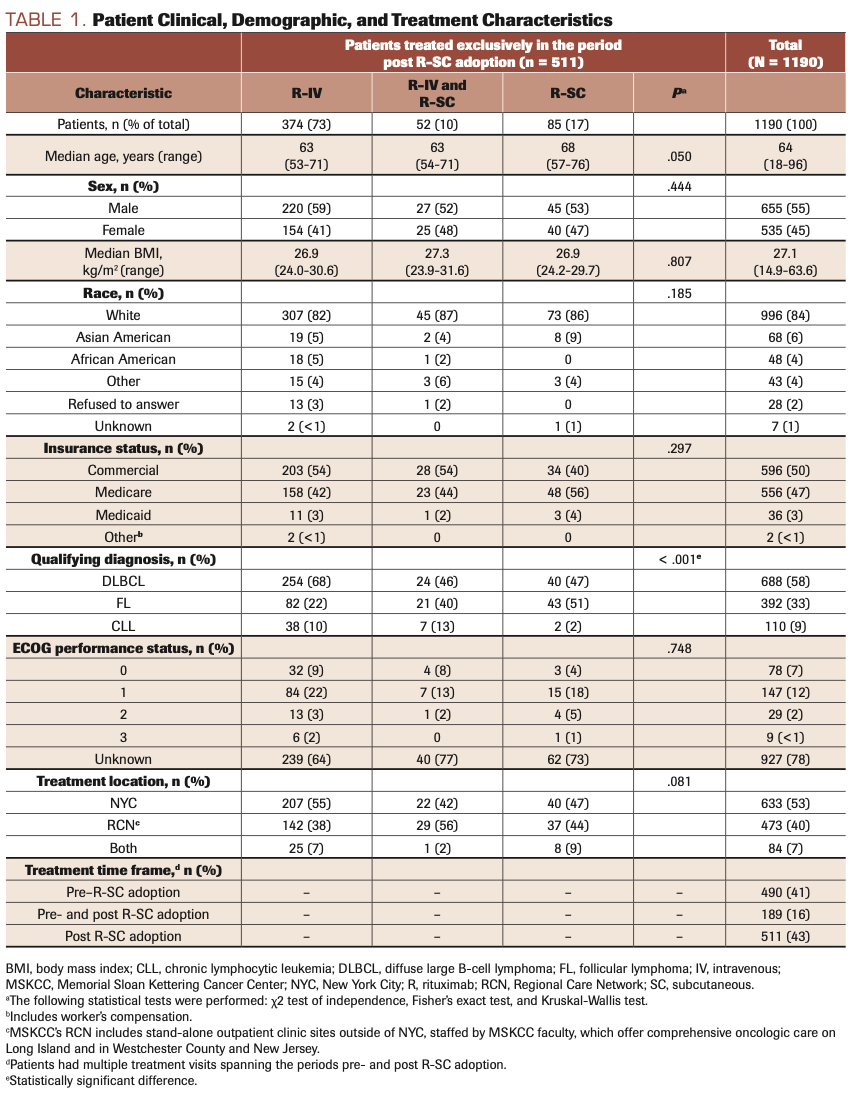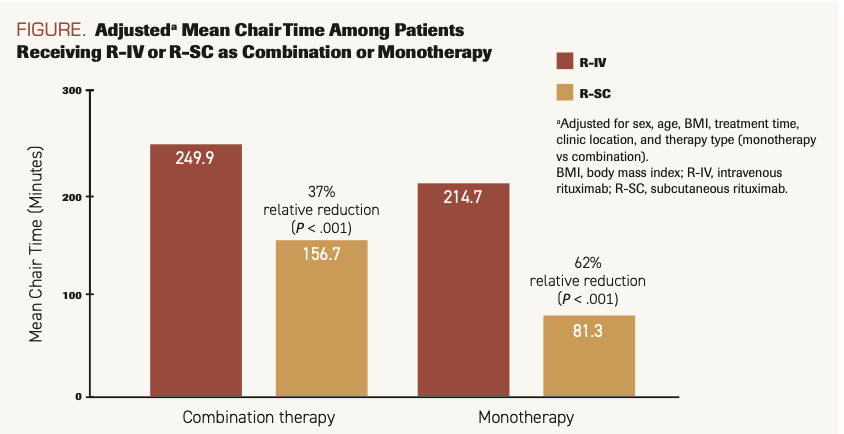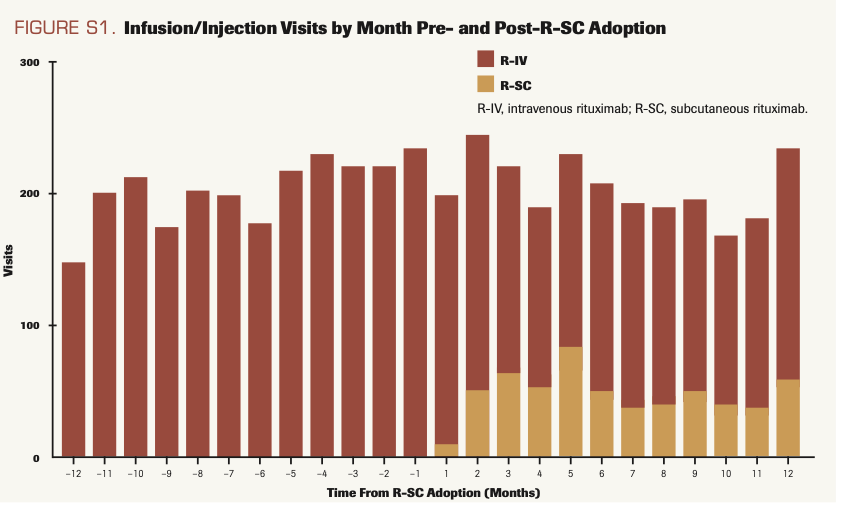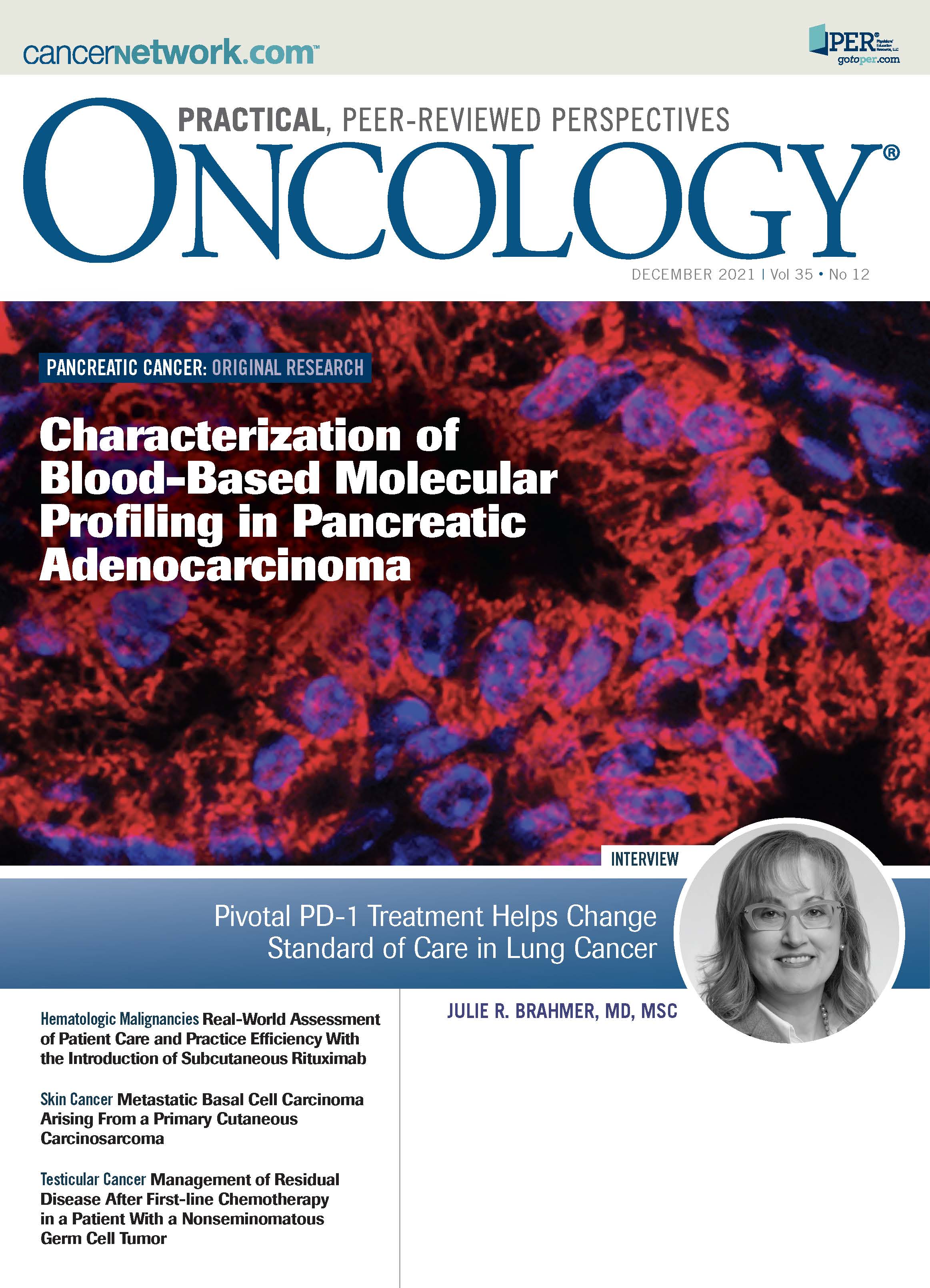Real-World Assessment of Patient Care and Practice Efficiency With the Introduction of Subcutaneous Rituximab
Rituximab-subcutaneously is associated with significantly reduced chair time vs rituximab-intravenously in a US oncology setting. Widespread adoption would be expected to improve practice efficiency and patient access to care, and to reduce health care resource burden.
Introduction
Rituximab (Rituxan; Genentech) is a chimeric anti-CD20 monoclonal antibody widely used in non-Hodgkin lymphoma (NHL) treatment.1 Worldwide, rituximab is recommended for a variety of B-cell malignancies,1,2 and it has a well-established efficacy and safety profile, with more than 4 million patients treated.1,3 In the United States, rituximab is approved for use in adults with non-Hodgkin lymphoma (NHL), including follicular lymphoma (FL) and diffuse large B-cell lymphoma (DLBCL), and chronic lymphocytic leukemia (CLL).4
The original intravenous (IV) formulation has prolonged infusion times and is associated with significant resource needs. The first infusion is given at a slower rate to reduce the risk of infusion-related reactions, which may be severe.2 This takes 4 or more hours,2 and although a 90-minute rapid infusion protocol was introduced in 2012 for second and subsequent infusions in which rituximab is coadministered with IV chemotherapy,2,5 infusion duration remains a challenge for patients and health care providers.5 Moreover, care provision during chemotherapy infusion requires significant resources, including pharmacy and nursing time, infusion facilities, and a relatively slow working pace.6
To address this, a subcutaneous (SC) formulation, combining a 12-fold increase in concentration of the monoclonal antibody with recombinant human hyaluronidase (rHuPH20) to increase dispersion and absorption, has been developed (Rituxan Hycela; Genentech).6,7 This requires administration over 5 to 7 minutes, with 15 minutes of monitoring after administration.2,8 At flat doses, rituximab SC (R-SC) showed comparable efficacy and safety to rituximab IV (R-IV) in several clinical trials,7,9-12 and the US FDA (2017) and European Medical Association (2014 [FL and DLBCL] and 2016 [CLL]) have approved its use in DLBCL, FL, and CLL.2,8
Patient preference and satisfaction, and time-motion data from clinical trials, favor SC formulation use. These data indicate that increased R-SC use is likely to result in time and resource savings, potentially leading to increased care access to health care providers for patients.13,14 Outside of clinical trials, data on patient care are limited, as are practice efficiency implications of widened use of R-SC in a US oncology setting. Using real-world US data, this analysis assesses patient care delivery and practice efficiency changes, measured by changes in chair occupancy time, as well as prescribing patterns before and after R-SC adoption. The research was carried out at Memorial Sloan Kettering Cancer Center (MSKCC), a comprehensive cancer center with locations in New York City (NYC), Long Island, Westchester County, and New Jersey.
Oncology (Williston Park). 2021;35(12):804-811.
DOI: 10.46883/2021.25920935
Methods
Study Design
This was a single-center, retrospective, observational analysis. Patients were identified based on diagnosis and delivery of a rituximab-containing regimen; data were extracted for the period of September 2016 through September 2018 (R-SC was added to the hospital formulary at MSKCC in September 2017).
MSKCC’s Regional Care Network (RCN) sites outside of NYC are stand-alone outpatient clinics, staffed by MSKCC faculty that offer comprehensive oncology care. Each site sees a heterogeneous patient population across the spectrum of cancer diagnoses, although each site has at least 1 member of the lymphoma service delivering outpatient care to patients with B-cell lymphomas. The outpatient infusion suites in NYC (per the data reported herein) are more disease specific, and those chemotherapy units are often limited to a narrower range of diagnoses and treatments. Many physicians treat patients at more than 1 MSKCC site (typically both NYC and 1 regional location).
This research was approved by the MSKCC Institutional Review Board prior to initiation of study-related activity.
Eligible patients were those represented in MSKCC data with the following criteria: DLBCL, FL, or CLL diagnosis; receiving a rituximab-containing regimen for the qualifying diagnosis at MSKCC during the study period; and 18 years or older at the time of the rituximab-containing regimen initiation. Follow-up visits for rituximab-based treatment that were missing room-in or room-out times were excluded.
Data Collection
Data were collected from MSKCC’s clinical and institutional databases, including the Clinical Information System, Epic (scheduling software for patient arrival, room-in, and room-out times), and the electronic medical record (EMR).
Per approved prescribing information,2,8 patients receive R-IV as the first rituximab treatment at the initial visit, which usually takes longer than subsequent visits.2,8,14 Therefore, and as all patients receive the first dose as an IV infusion regardless of subsequent treatment route (R-IV/R-SC), each patient’s initial visit was excluded. Thus, if a patient only had 1 visit during the study period, that patient was not included.
Outcome Measures
Primary outcome measures were chair occupancy time before and after R-SC adoption, by treatment type (R-IV/R-SC), time of day and day of the week, and clinic location (NYC/RCN). Chair occupancy was defined as the difference between patient room-in and room-out times as per the EMR timestamp data. Prescribing patterns were a secondary outcome, and they were assessed in patients treated exclusively in the post–R-SC
adoption period. Outcomes are presented by overall population and stratified by combination vs monotherapy.
Statistical Analysis
A linear mixed-effects multivariable model with random intercept was used to analyze the association between treatment type and chair time in the year prior to, and the year following, R-SC adoption at MSKCC. Random intercept accounted for repeated measures within patients. Model covariates were sex, age, body mass index (BMI), treatment time (morning vs afternoon; effect of day of week), clinic location (regional vs local), months since SC implementation, and therapy type (monotherapy vs combination). Sex, age, BMI, therapy type, and months since SC implementation were determined a priori, and remaining covariates were selected if they were significant in the association between treatment type and chair time.
A logistic mixed-effects multivariable model was used to analyze the association between diagnosis and age on administration route. Prescriber was set as a random effect to account for clustering of patients at the doctor level; diagnosis and age were fixed effects. The model estimates the effects of both diagnosis and age, and it accounts for prescriber “tendency” on the prescribed route of rituximab administration.
Data were analyzed using R version 3.5.3 (The R Project for Statistical Computing).
Results
Patient Characteristics
Overall, 1190 patients were analyzed. Patient and treatment characteristics are outlined in Table 1. In total, 490 (41%) patients received all treatment pre–R-SC adoption, 511 (43%) received all treatment post R-SC adoption, and 189 (16%) received treatment both pre- and post R-SC adoption.
TABLE 1. Patient Clinical, Demographic, and Treatment Characteristics

To fairly compare patient and treatment characteristics by rituximab administration route, we analyzed the 511 (43%) patients who received all treatment post–R-SC adoption (R-IV: n = 374 [73%]; R-SC: n = 85 [17%]; R-IV and R-SC: n = 52 [10%]). Most patients receiving R-IV had DLBCL (n = 254 [68%]), whereas the largest proportion of patients receiving R-SC had FL (n = 43 [51%]). Most patients with CLL were treated with R-IV (n = 38/47 [81%]), accounting for 10% of the R-IV arm. Except for age and qualifying diagnosis, baseline characteristics (Table 1) were similar between treatment groups. Patients receiving R-SC were older overall (median age, 68 years) than those receiving R-IV (median age, 63 years) and those receiving both R-SC and R-IV (median age, 63 years).
Treatment Visit Data
Data were collected over 5129 rituximab visits (pre–R-SC adoption: 2565; post R-SC (adoption: 2564; Supplementary Figure). Of all visits, 4526 (88%) were for R-IV (combination therapy: 58%; monotherapy: 43%). R-SC accounted for 603 visits (12%; combination therapy: 54%; monotherapy: 46%).
Chair Time Savings
Patients receiving R-IV combination therapy had a mean chair time of 249.9 minutes. The linear mixed-effects model showed that R-SC reduced combination therapy chair time vs R-IV by a mean of 93.2 minutes (P < .001), equivalent to a 37% relative reduction (Figure; Table 2). Overall, monotherapy, regardless of administration route (R-IV/R-SC), reduced chair time by a mean of 35.2 minutes (P < .001) vs combination therapy. Mean chair time was further reduced by 40.2 minutes (P < .001) with R-SC monotherapy, resulting in total chair time savings of 133.4 minutes vs R-IV monotherapy (relative reduction, 62%; Figure). Reductions in chair time also increased over time following initial R-SC adoption (P = .004) (Table 2).
FIGURE. Adjusteda Mean Chair Time Among Patients Receiving R-IV or R-SC as Combination or Monotherapy

TABLE 2. Linear Mixed-Effects Multivariate Model on Chair Time in Minutes (room out-time minus room in-time) With Age, Sex, and BMI

Since R-SC adoption in MSKCC (which occurred over the course of the year between September 2017 and September 2018), total predicted mean chair time savings were 30,039 minutes (R-SC combination therapy) and 37,240 minutes (R-SC monotherapy) in 603 visits, translating to 500.65 hours and 620.67 hours per year of chair time savings, respectively.
Comparisons based on days of the week showed the effect of patient volume/flux throughout a 7-day period, with a tendency for chair time to increase as the week progressed, and with substantially longer chair times on the weekends (Table 2). Treatment in the afternoon vs the morning was associated with a 20.8-minute mean reduction in chair time (P < .001).
Prescribing Pattern
Prescribing information was available for 506 of 511 (99%) patients treated exclusively in the period post R-SC adoption, with 1870 visits (R-IV: n = 1430 [76%]; R-SC: n = 440 [24%]). Overall, 408 (81%) patients were first prescribed R-IV, while 98 (19%) patients were first prescribed R-SC. Of the patients initially prescribed R-IV, 39 (10%) were switched to R-SC; of these, 3 (8%) patients were switched back to R-IV. Of the patients initially prescribed R-SC, 12 (12%) were switched to R-IV. Switching back to R-IV was per patient preference.
Twenty doctors prescribed for 15 or more patients who were treated exclusively in the post–R-SC adoption period; among these, heterogeneous patterns in R-SC prescribing were observed. There was a wide range, from 0% to 63% of the time, in the frequency of visits in which doctors prescribed R-SC. This difference can be partially explained by patient diagnosis and age. Doctors were more likely to prescribe R-SC to patients with FL than with DLBCL (odds ratio [OR], 2.38; 95% CI, 1.75-3.25; P < .001), influenced by a service-level decision to favor R-IV for DLBCL, given the curative intent of therapy. Each additional year of a patient’s age increased the odds of prescribing R-SC by 2% (OR, 1.02; 95% CI, 1.01-1.03; P < .001). Beyond this, there were large differences in prescriber “tendency” to prescribe R-SC vs R-IV as measured by random effect (least likely to prescribe R-SC [−2.42]; most likely to prescribe R-SC [2.30]). Of the 5 doctors who prescribed R-SC for fewer than 10% of their patients, 2 did not prescribe R-SC at all, and 3 prescribed R-SC only when a patient had already been started on R-SC by another member of the lymphoma service.
FIGURE S1. Infusion/Injection Visits by Month Pre- and Post-R-SC Adoption

Discussion
Health systems and oncology practices need to balance the primary mission of delivering the highest quality care to patients with recognition of and response to an increasingly challenging economic and reimbursement landscape. Rapid growth in health care expenditures,15,16 with limitations on health care resources, necessitate intervention evaluations from a clinical resource management perspective. The economic significance of rituximab in B-cell lymphoma treatment has fueled initiatives such as the development of biosimilar agents and exploration of the SC administration route.1 While biosimilars have lower acquisition costs than the rituximab reference product, they require IV administration.1 SC administration offers the potential to administer rituximab in a manner that minimizes clinic resource use and time, while maximizing patient convenience and satisfaction.13,17
From the perspective of clinical workflow, we found that R-SC adoption resulted in substantial time savings for both the patient and health system as measured by reduced chair time. Compared with R-IV, mean chair time was reduced by 37% when patients received R-SC as part of combination therapy, and by 62% when they received R-SC monotherapy. Strategies to better leverage this reduction in chair time for individual practices may include assessment of variation across providers, histologies, and practice sites, as well as days of the week; at MSKCC, the observation that median chair times are longer later in the week affords a potential opportunity to align elective treatments with R-SC on these days.
Our findings mirror those obtained in clinics across non-US health care systems within the context of clinical trial-based care. A United Kingdom time–motion study, conducted alongside the phase 3b MabCute trial of maintenance R-SC in 276 patients with relapsed/refractory NHL,18 found patient time per session in the treatment room to be 263.8 minutes (95% CI, 236.6-294.3) for R-IV and 70.0 minutes (95% CI, 57.1-87.2) for R-SC, a reduction of 73%. R-SC was associated with savings of 174.8 minutes (95% CI, 172.5-177.1) in total active health care practitioner time and reduced total mean per-session staff costs by £115.17 (95% CI, 98.95-136.93).19
A wider study across 30 oncology centers in Europe and South America, again conducted alongside MabCute, found reductions of 27% to 58% in health care provider time for the treatment process (including drug preparation; overall 32% reduction) and relative reductions in mean patient chair time of 53% to 91% (overall 74% reduction; P < .0001) with R-SC vs R-IV.14 A systematic survey carried out in 17 Italian cancer centers found a reduction of 70% in mean administration time for every cycle where R-SC was used in place of R-IV in patients with NHL; over 8 cycles, including the first IV dose, the reduction was 59%.20 A chart review in Canada estimated a savings of more than 50,000 treatment suite hours in the third year following R-SC adoption.21 Time savings were estimated to be greater in FL patients than DLBCL patients, which was of interest as the prescribers in the current study were more likely to prescribe R-SC to FL patients.
The present results suggest that R-SC can result in substantial time savings for both patients and health systems, which may improve practice efficiency and allow more patients to be treated in a finite treatment space over a set period of time, ultimately improving patient care. From a societal perspective, the potential benefits for patients and caregivers are considerable. Reduced chair time would be expected to translate into reduced time in the infusion suite (assuming parity for other hospital-based activities for IV and SC processes), with associated improvement in convenience and patient burden. This aligns with the experience from the PrefMab study in 743 patients with previously untreated FL or DLBCL, which showed an overall patient preference for R-SC over R-IV; in turn, this was associated with increased patient-reported satisfaction.13
The reductions in health care resource utilization that are likely to accrue from the adoption of R-SC over R-IV, as strongly indicated by the results of both this study and of other published literature, suggest that R-SC administration has the potential to impact routine clinical practice in FL, DLBCL, and CLL treatment. The adoption of fixed-dose SC administration reduces pharmacy work involved in IV medication preparation,22 chair utilization, and nursing hours required in medicine administration and posttreatment monitoring. Studies demonstrating the clinical equivalence and pharmacokinetic noninferiority of R-SC against R-IV suggest that these aims can be achieved without loss of efficacy.7,9-11,23
Heterogeneous prescribing patterns were observed among doctors at MSKCC who prescribed R-SC, which were likely influenced by disease and prior route of rituximab administration. Large differences in doctors’ tendencies to prescribe R-SC over R-IV were noted; of the doctors with the most rituximab patients treated exclusively in the period post R-SC adoption, 25% either did not prescribe R-SC or prescribed it only to patients already receiving it.Heterogeneity in prescribing patterns can be problematic, particularly in the cases when it leads to avoidable health service costs and suboptimal patient care.24 This observation highlights the potential for higher center-level impact with further education for doctors on the availability and utility of R-SC, as well as the adoption of a standardized treatment approach.
While this study predated SARS-CoV-2 and the COVID-19 pandemic, implications for the improved workflow associated with R-SC may be magnified under current conditions. Given concerns regarding nosocomial risk—to patients and staff—the marked reduction in time that health care providers and patients must share close quarters, and the cumulative time that patients are in the infusion center, may be critically relevant.25
Limitations
This is the first US-based study to demonstrate time savings with the use of R-SC vs R-IV. Limitations are typical of analyses based on retrospective chart data. The information is reported as recorded by clinicians and is subject to potential data entry errors, and there is a risk that the retrospective EMR time stamp (used as a proxy for chair time) may not always be accurate. The generalizability of our results may also be limited to institutions with similar organizational structure to MSKCC, although the consistency of our results with those obtained in studies in several other jurisdictions suggests that this is unlikely to be a major concern. Institutional time savings will be dependent upon patient diagnoses and the relative proportion of patients receiving rituximab-based therapy.
Conclusions
In conclusion, we have demonstrated time savings associated with R-SC use in a high-volume US cancer center. Given the growing constraints on chair time available for infusion therapy in patients who are prescribed rituximab, increasing R-SC utilization is likely to improve practice efficiency, improve patient care access, and reduce health care resource burden, particularly when a substantial fraction of overall patient volume is composed of lymphoma treatment. Increased understanding of the impact of R-SC adoption on the ability to deliver efficient patient care will further inform key practice decisions in real-world settings.
AUTHOR AFFILIATIONS:
1. Department of Epidemiology & Biostatistics, Memorial Sloan Kettering Cancer Center, New York, NY, USA
2. Lymphoma Service, Department of Medicine, Memorial Sloan Kettering Cancer Center, New York, NY, USA
3. Evidence for Access, Genentech, Inc, South San Francisco, CA, USA
4. US Medical Affairs, Genentech, Inc, South San Francisco, CA, USA*
*Currently: Product Development Medical Affairs, Genentech, Inc., South San Francisco, CA.
Disclosures:
ED, AQ, JS: No conflicts of interest to declare. SS, TMT, AR, KD: Employee of Genentech, Inc, stocks/stock options in Genentech, Inc/
F. Hoffmann-La Roche Ltd. MM: Research funding and honoraria from Genentech, Inc.
Equal contribution
ED and AQ contributed equally.
Corresponding author
Matthew Matasar, MD, Department of Medicine, Lymphoma Service, Memorial Sloan Kettering Cancer Center, 1275 York Ave, New York, NY 10065. Email: matasarm@mskcc.org; phone: 646-497-9137.
Research support
This study was funded by Genentech, Inc. Third-party medical writing assistance, under the direction of Sheila Shapouri, was provided by Lynda McEvoy and Zoe Toland, of Ashfield MedComms, an Ashfield Health company, and was funded by F. Hoffmann-La Roche Ltd.
References
1. Pierpont TM, Limper CB, Richards KL. Past, present, and future of rituximab – the world’s first oncology monoclonal antibody therapy. Front Oncol. 2018;8:163. doi:10.3389/fonc.2018.00163
2. MabThera. Prescribing information. F. Hoffmann-La Roche; 2020. Accessed November 16, 2021. https://www.ema.europa.eu/en/documents/product-information/mabthera-epar-product-information_en.pdf
3. F Hoffmann-La Roche Ltd. MabThera periodic benefit–risk evaluation report. Data on file; 2019.
4. Rituxan (rituximab) injection, for intravenous use. Prescribing information. Genentech; 2021. Accessed November 19, 2021. https://www.gene.com/download/pdf/rituxan_prescribing.pdf
5. Yelvington BJ. Subcutaneous rituximab in follicular lymphoma, chronic lymphocytic leukemia, and diffuse large B-cell lymphoma. J Adv Pract Oncol. 2018;9(5):530-534.
6. Shpilberg O, Jackisch C. Subcutaneous administration of rituximab (MabThera) and trastuzumab (Herceptin) using hyaluronidase. Br J Cancer. 2013;109(6):1556-1561. doi:10.1038/bjc.2013.371
7. Davies A, Merli F, Mihaljevic B, et al. Pharmacokinetics and safety of subcutaneous rituximab in follicular lymphoma (SABRINA): stage 1 analysis of a randomised phase 3 study. Lancet Oncol. 2014;15(3):343-352. doi:10.1016/S1470-2045(14)70005-1
8. Rituxan hycela (rituximab and hyaluronidase human) injection, for subcutaneous use. Genentech; 2021. Accessed November 16, 2021. https://www.gene.com/download/pdf/rituxan_hycela_prescribing.pdf.
9. Davies A, Merli F, MihaljeviĆ B, et al. Efficacy and safety of subcutaneous rituximab vs intravenous rituximab for first-line treatment of follicular lymphoma (SABRINA): a randomised, open-label, phase 3 trial. Lancet Haematol. 2017;4(6):e272-e282. doi:10.1016/S2352-3026(17)30078-9
10. Lugtenburg P, Avivi I, Berenschot H, et al. Efficacy and safety of subcutaneous and intravenous rituximab plus cyclophosphamide, doxorubicin, vincristine, and prednisone in first-line diffuse large B-cell lymphoma: the randomized MabEase study. Haematologica. 2017;102(11):1913-1922. doi:10.3324/haematol.2017.173583
11. Assouline S, Buccheri V, Delmer A, et al. Pharmacokinetics, safety, and efficacy of subcutaneous versus intravenous rituximab plus chemotherapy as treatment for chronic lymphocytic leukaemia (SAWYER): a phase 1b, open-label, randomised controlled non-inferiority trial. Lancet Haematol. 2016;3(3):e128-e138. doi:10.1016/S2352-3026(16)00004-1
12. Salar A, Avivi I, Bittner B, et al. Comparison of subcutaneous versus intravenous administration of rituximab as maintenance treatment for follicular lymphoma: results from a two-stage, phase IB study. J Clin Oncol. 2014;32(17):1782-1791. doi:10.1200/JCO.2013.52.2631
13. Rummel M, Kim TM, Aversa F, et al. Preference for subcutaneous or intravenous administration of rituximab among patients with untreated CD20+ diffuse large B-cell lymphoma or follicular lymphoma: results from a prospective, randomized, open-label, crossover study (PrefMab). Ann Oncol. 2017;28(4):836-842. doi:10.1093/annonc/mdw685
14. De Cock E, Kritikou P, Sandoval M, et al. Time savings with rituximab subcutaneous injection vs rituximab intravenous infusion: a time and motion study in eight countries. PLoS One. 2016;11(6):e0157957. doi:10.1371/journal.pone.0157957
15. Dieleman JL, Templin T, Sadat N, et al. National spending on health by source for 184 countries between 2013 and 2040. Lancet. 2016;387(10037):2521-2535. doi:10.1016/S0140-6736(16)30167-2
16. Global Burden of Disease Health Financing Collaborator Network. Future and potential spending on health 2015-40: development assistance for health, and government, prepaid private, and out-of-pocket health spending in 184 countries. Lancet. 2017;389(10083):2005-2030. doi:10.1016/S0140-6736(17)30873-5
17. Fargier E, Ranchon F, Huot L, et al. SMABcare study: subcutaneous monoclonal antibody in cancer care: cost–consequence analysis of subcutaneous rituximab in patients with follicular lymphoma. Ann Hematol. 2018;97(1):123-131. doi:10.1007/s00277-017-3147-y
18. Rule S, Barreto WG, Briones J, et al. Efficacy and safety assessment of prolonged maintenance with subcutaneous rituximab in patients with relapsed or refractory indolent non-Hodgkin lymphoma: results of the Phase III MabCute study. Haematologica. Published online June 17, 2021. doi:10.3324/haematol.2020.274803
19. Rule S, Collins GP, Samanta K. Subcutaneous vs intravenous rituximab in patients with non-Hodgkin lymphoma: a time and motion study in the United Kingdom. J Med Econ. 2014;17(7):459-468. doi:10.3111/13696998.2014.914033
20. Ponzetti C, Canciani M, Farina M, Era S, Walzer S. Potential resource and cost saving analysis of subcutaneous vs intravenous administration for rituximab in non-Hodgkin’s lymphoma and for trastuzumab in breast cancer in 17 Italian hospitals based on a systematic survey. Clinicoecon Outcomes Res. 2016;8:227-233. doi:10.2147/CEOR.S97319
21. Stewart DA, Boudreault JS, Maturi B, Boras D, Foley R. Evaluation of subcutaneous rituximab administration on Canadian systemic therapy suites. Curr Oncol. 2018;25(5):300-306. doi:10.3747/co.25.4231
22. Stewart D, Aucoin JS, Crosbie T, et al. Update on the subcutaneous administration of rituximab in Canadian cancer centres. Curr Oncol. 2020;27(2):113-116. doi:10.3747/co.27.6041
23. Assouline S, Buccheri V, Delmer A, et al. Pharmacokinetics and safety of subcutaneous rituximab plus fludarabine and cyclophosphamide for patients with chronic lymphocytic leukaemia. Br J Clin Pharmacol. 2015;80(5):1001-1009. doi:10.1111/bcp.12662
24. Walker AJ, Pretis F, Powell-Smith A, Goldacre B. Variation in responsiveness to warranted behaviour change among NHS clinicians: Novel implementation of change detection methods in longitudinal prescribing data. BMJ. 2019;367:l5205. doi:10.1136/bmj.l5205
25. Jafarey A. Ethical dilemmas in clinical care during COVID-19 pandemic. J Pak Med Assoc. 2020;70(5):S145-S148. doi:10.5455/JPMA.35

Navigating AE Management for Cellular Therapy Across Hematologic Cancers
A panel of clinical pharmacists discussed strategies for mitigating toxicities across different multiple myeloma, lymphoma, and leukemia populations.
Late Hepatic Recurrence From Granulosa Cell Tumor: A Case Report
Granulosa cell tumors exhibit late recurrence and rare hepatic metastasis, emphasizing the need for lifelong surveillance in affected patients.